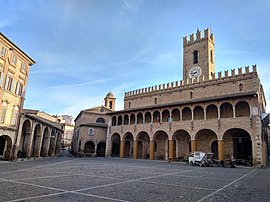Offida
| Offida | ||
|---|---|---|

|
|
|
| Country | Italy | |
| region | Brands | |
| province | Ascoli Piceno (AP) | |
| Coordinates | 42 ° 56 ' N , 13 ° 42' E | |
| height | 292 m slm | |
| surface | 49.22 km² | |
| Residents | 4,893 (Dec 31, 2019) | |
| Population density | 99 inhabitants / km² | |
| Post Code | 63035 | |
| prefix | 0736 | |
| ISTAT number | 044054 | |
| Popular name | Offidani | |
| Patron saint | San Leonardo | |
| Website | Offida | |
 Offida, view of the town hall |
||
Offida is an Italian municipality in the province of Ascoli Piceno in the Marche region and is a member of the I borghi più belli d'Italia association (The Most Beautiful Places in Italy).
history
According to archaeological finds near Offida, it is assumed that a settlement already existed in the Stone Age.
Probably in the 9th century BC Some Picenians , who emerged from a group of Sabines , founded Offida. Around the 3rd century BC The Picenian culture disappeared with the advance of the Romans . In the 6th century AD the Lombards conquered Italy, Offida in 580 AD.
A few decades later (7th century) a castle in this village was named that way. From around the 9th century Offida experienced an agricultural heyday thanks to the Benedictine monks from Farfa . During this time, a town hall and a city wall were also built. In the 13th century, Offida was mentioned as a city in a mention of Pope Urban IV . Open rivalries developed between two ruling families ( Ghibellines and Guelphs ). The fighting continued until the end of the 16th century; In 1533 the entire Baroncelli (Welfen) family was killed.
Offida continued to develop under the control of the Church. In 1808, the rule of the papal state was abolished by Napoleon . It was reintroduced as early as 1815 by the Congress of Vienna . There was a subdivision into city districts, an administration (mayor, municipal council, mayor, village elder). But in 1860 the church army was defeated by Piedmontese troops and Offida was assigned to the province of Ascoli Piceno . The town of Offida, until now rural, has been increasingly industrialized by handicrafts.
In 1926 Offida received an electric tram that led to Castel di Lama , about 11 kilometers south, and brought the connection to the railway line from Ascoli Piceno to San Benedetto del Tronto / Porto d'Ascoli. In 1952 it was replaced by buses.
After the Second World War , industrialization and modernization continued to develop. In addition, they focused on the craft and especially cultivated the art and dissemination of lace .
Origin of name
The origin of the name is not known. Historians suspect a derivation from:
- OPPIDA (Italian: fortified city)
- OPHYS (Greek: snake)
- OPHIDA (Italian: extensive hill)
Attractions
Eight churches and a monastery remind of the long church rule. Today's theater "Serpente Aureo" was built in 1768 and expanded in 1820. In the 20th century, some modernization changes were made. The town hall is probably in the 11th / 12th. Century built. The city wall, some of which is still preserved today, dates from the 15th century.
Viticulture
A wine called " Offida " is produced in the hill country of the province of Ascoli Piceno.
Honorary citizen
Web links
- City history (Italian)
- Offida (German)
- Italien-inseln.de (German)
Individual evidence
- ↑ Statistiche demografiche ISTAT. Monthly population statistics of the Istituto Nazionale di Statistica , as of December 31 of 2019.
- ^ I borghi più belli d'Italia. Borghipiubelliditalia.it, accessed August 9, 2017 (Italian).



